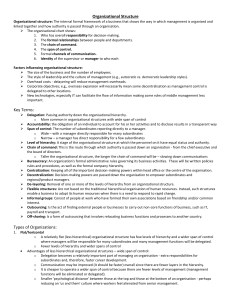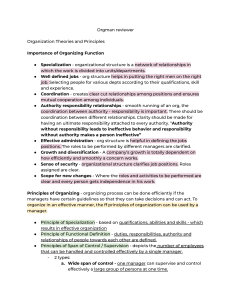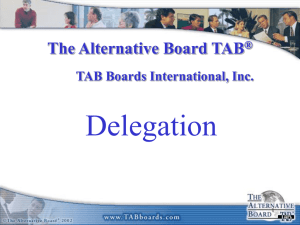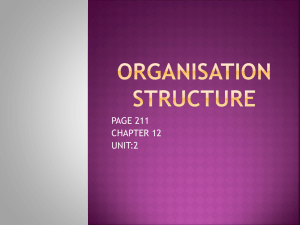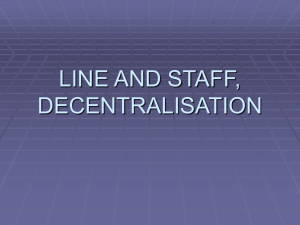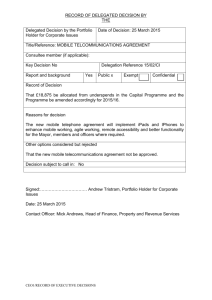File
advertisement
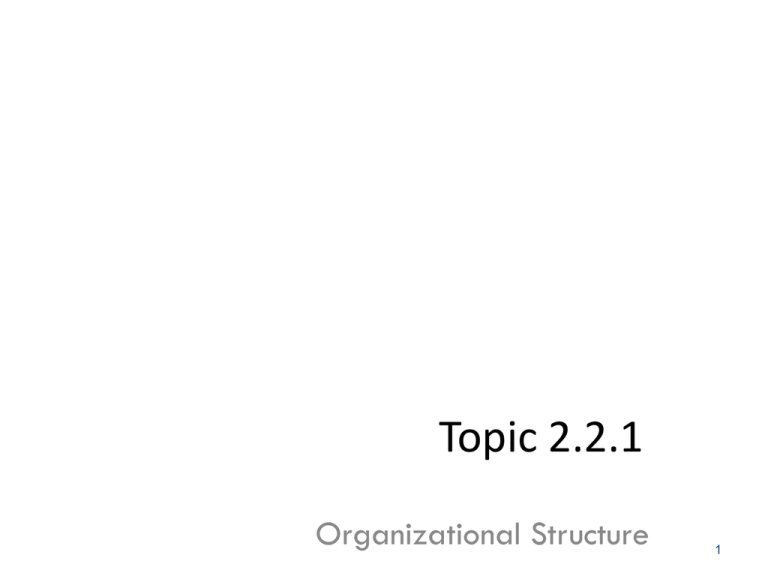
Topic 2.2.1 Organizational Structure 1 Organization Structure • Formal Organization: – “Refers to the official structures of command and control that exists in an organization.” – The formal relationships of authority. – Authority is delegated from senior middle junior managers. • Managers delegating are responsible of the outcomes. – Each level of management will tend to have written/unwritten rules that outline what can & cannot be done. 2 Continued… – The “formal organization” takes into account: • • • • • The relationships between individuals; Who is in charge; Who has authority to make decisions; Who carries out decisions; How information is communicated. 3 Continued… • Delegation: – Factors deciding the amount of authority to delegate: 1. 2. 3. 4. 5. The culture of the organization; The ability of the subordinate; The consequences of getting the decision wrong; The expectations of the managers and the subordinate; The amount of work the manager and subordinate have to do. 4 Continued… • When is delegation likely to be effective? – Employees need to be empowered in order to make effective decisions. – If managers only delegate when they are overloaded, subordinates may be resentful. – Managers should: • Plan and take time to explain delegated tasks clearly. • Allow participation. • Avoid interfering with delegated tasks. • Provide support and resources. – The employee given a delegated task should also be given the authority & responsibility to carry it out. – Delegated tasks should be given to suitable employees. 5 Continued… • Informal Organization: – “Refers to the unofficial organization of personal & social relations that develop in an organization.” – Power comes from informal groups in the organization. – Doesn’t officially exists, thus difficult to set rules and identify individual representatives. – The types of relationship (1993 – study of informal networks in the banking industry – by: Krachhardt & Hanson): A. Advice Networks: who depends on who to solve problems and provide information. B. Trust Networks: which employees share potential information and back each other up in times of crisis. C. Communication Networks: which employees regularly talk to each other on work related patterns. 6 Levels of Hierarchy • Hierarchy: “the order of levels of management in an organization, from the lowest to the highest rank.” • Responsibility: “Being accountable or being required to justify an action.” • Authority: “Ability to carry out the task.” • Levels of hierarchy: – Flat & Tall Organizations – Chain of Command – Organizational Charts 7 Flat & Tall Organizations TALL Organization 8 Continued… • TALL Organizations: – As an organization grows, it is likely that: • People become relatively more specialized; • Rules will need to be put in place; • Lines of command and control will become clearer. – Characteristics: • Bureaucracy: “a system where there are standardized procedures, formal divisions of power, rigid hierarchy, and formal working relationships.” • Long chain of command. • Usually used for stable business environments. • Centralized decision making. 9 Continued… • Advantages: – There is a narrow span of control i.e. each manager has a small number of employees under their control. This means that employees can be closely supervised. – There is a clear management structure. – The function of each layer will be clear and distinct. There will be clear lines of responsibility and control. – Clear progression and promotion ladder. • Disadvantage: – The freedom and responsibility of employees (subordinates) is restricted. – Decision making could be slowed down as approval may be needed by each of the layers of authority. – Communication has to take place through many layers of management. 10 Continued… FLAT Organization 11 Continued… • FLAT Organizations: – Characteristics: • Fewer levels of management. • Decentralized decision making, and employee participation is encouraged. • Managers are closer to subordinates have a more personal working relationship. • Structure aims to create autonomous/independent units that are: – Closer to customers, AND – Can quickly identify and respond to changes in internal and external business situations. 12 Continued… • Advantages: – – – – – Closer relationships Synergy Change accepted faster Spread of decision making Motivation • Disadvantage: – Decision making slow and frustrating as so many employees involved – Confusing as the source of power and decisions are less clear compared to tall 13 Chain of Command • “The line of authority and responsibility along which orders are passed in a formal organization.” • Should consider two factors: – The number of links/levels in the chain of command. • Each extra level of management in the hierarchy 25% less effective communication. – Span of control: “number of subordinates working under a manager.” • Henri Fayol argued that the span of control should be between three & six because: – There should be tight managerial control from the top of the business; – There are physical & mental limitations to any single manager’s ability to control people and activities. 14

